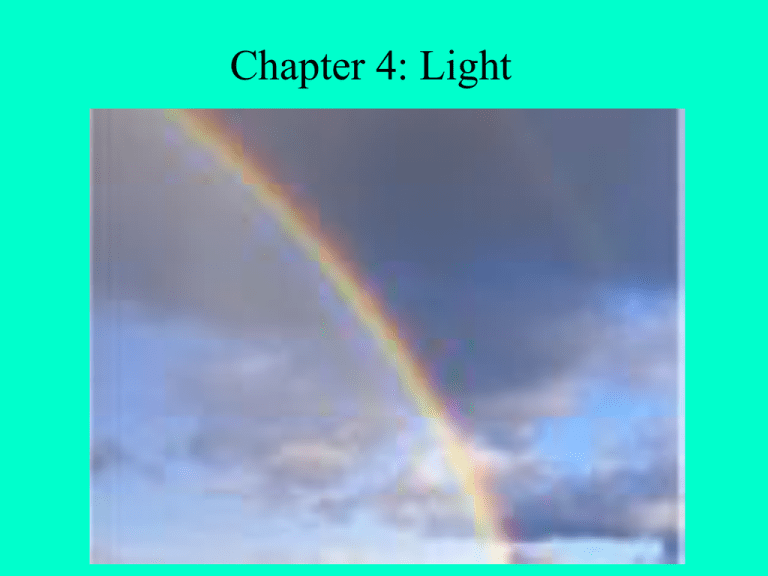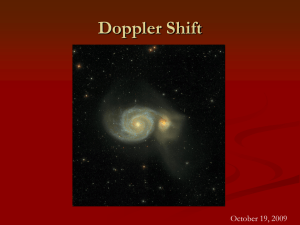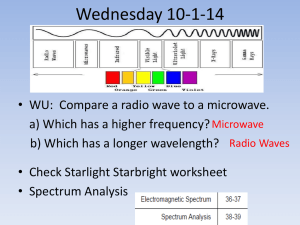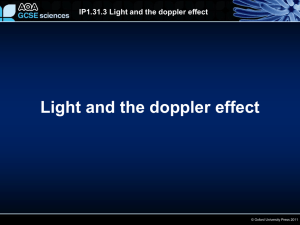Light
advertisement

Chapter 4: Light “Ever since we crawled out of that primordial slime, that’s been our unifying cry, ’More light.’ Sunlight. Torchlight. Candlelight. Neon, incandescent lights that banish the darkness from our caves to illuminate our roads, the insides of our refrigerators...Little tiny flashlights for those books we read under the covers when we’re suppose to be asleep. Light is more than watts ... Light is metaphor. Light is knowledge. Light is life...” - Diane Frolov and Andrew Schneider Northern Exposure,1993 What can we learn by analyzing starlight? • A star’s chemical composition • A star’s temperature • A star’s speed and direction of motion How fast does light move? • 186,000 miles per second! or • 3 x 105 kilometers per second! Nothing travels faster than light! Particle or Wave ? 1905, Einstein verified that light sometimes behaves as a wave and sometimes as particles. This is called the waveparticle duality of light! Particle or Wave ? Wave: Electromagnetic wave Particles: Photons (packets of energy) Light as a Wave Different wavelengths correspond to different colors! Units: 1 nanometer= 10-9 meters! Light as a Wave Some Important Relationships if wavelength↓, then frequency ↑ if frequency ↑, then energy ↑ if wavelength ↓, then energy ↑ Concept Question Which color light has more energy blue or red? Blue coats beat the red coats! If you pass white light through a prism, it separates into its component colors. Spectrum ROY G. BIV !! long wavelengths short wavelengths A hot object or a hot, dense gas produces a continuous spectrum -- a complete rainbow of colors without any specific spectral lines. A hot, less dense gas, when heated, produces an emission line spectrum - a series of bright spectral lines against a dark background. A cooler gas in front of a hot dense gas produces an absorption line spectrum - a series of dark spectral lines among the colors of the rainbow. Each chemical element produces its own unique set of spectral lines when it burns Spectral Lines By observing the location of the emission and or the absorption lines, one can identify the element!!!! Twinkle, twinkle little star I don’t wonder what you are. For by spectroscopic ken I know that you are hydrogen! - anonymous The Spectral Type of Stars • stars are classified by their spectral types: O BAFGK M • hottest to coolest • most massive to least massive • shortest lifetime to longest lifetime Stars are classified by their spectra as O, B, A, F,G, K, and M spectral types Oh Be A Fine Guy (or Girl), Kiss Me Figure 3.5 Electromagnetic Spectrum Not all radiation can penetrate Earth’s atmosphere. What is Color? • Color of objects due to how much light is reflected, absorbed, or emitted. Kelvin Temperature Scale Kelvin Temperature = Celsius Temperature + 273 Peak color (wavelength) shifts to shorter wavelengths as the temperature increases increasing temperature Which is HOTTER??? Peak color (wavelength) shifts to shorter wavelengths as the temperature increases Humans emit infrared light! The Doppler Shift Christian Doppler 1842: • the observed frequency of an object is affected by its apparent motion • Doppler shift occurs when the source of the waves is moving with respect to the observer • occurs for all waves (e.g. water, sound, light) The Doppler Shift Sound Waves low pitch low frequency long wavelength high pitch high frequency short wavelength The Doppler Shift Light Waves Stationary Star A Star Moving to the Right B constant wavelength detected by both A and B A B A detects longer wavelength redshift B detects shorter wavelength blueshift The Doppler Shift In Astronomy Spectrum of Approaching Source Spectrum of Stationary Source Spectrum of Receding Source 400nm 550nm 700nm Detection of Extrasolar Planets: Stellar Wobble • gravity of the planet causes the star to wobble back and forth • 1990s, used Doppler effect to detect stellar wobbles Concept Question If a star is moving away from us, which statement best describes what is happening to the star’s light? A) the light is blueshifted; we perceive that the wavelength increases B) the light is redshifted; we perceive that the wavelength increases C) the light is blueshifted; we perceive that the wavelength decreases D) the light is redshifted; we perceive that the wavelength decreases What can we learn by analyzing starlight? • A star’s chemical composition – by spectrum • A star’s temperature – by color (peak wavelength) • A star’s speed and direction of motion – by spectrum and Doppler Shift











